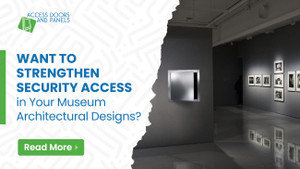Want to Strengthen Security Access in Your Museum Architectural Designs?
Posted by Access Doors and Panels on 12th Jul 2023
Museums are guardians of art, history, and knowledge, preserving the most prized treasures spanning the ages. In an ever-evolving landscape of security circumstances, architects play a vital role in crafting museum spaces that captivate, inspire, protect, and defend. Today, we embark on an exciting journey through the myriad ways architects can elevate the security of their museum designs.
Boosting the safety system of museums requires a multifaceted approach that unites architectural design, technology, and procedural measures. Below are several key ways architects can improve the security of museum designs:
Establish a Secure Perimeter
Architects can strategically design the museum's layout while considering security factors like controlled access points, secure parking areas, and landscaping that doesn't give away hiding spots for potential intruders. Placing barriers like fences, bollards, or natural elements can also help establish a secure perimeter around the gallery establishment.
Add Secured Entry Points
Enforcing robust access control systems is critical. It includes adding specific entry points, such as turnstiles or controlled doors, with authentication methods like key cards, biometrics, or facial recognition. Access control systems empower authorities to monitor and prohibit entry to authorized personnel, guaranteeing only authorized individuals gain access, especially to sensitive spaces.
Install Security Access Doors
Another way for architects to maintain an orderly and protected access system is by attaching sturdy and reliable security access doors with medium and high-security levels depending on their use. Here are some of the trendiest protective doors highly recommended for installation in a museum project:
Medium-Security Access Doors:
Cendrex MDS Medium Security Panel: For museums and art galleries looking to add locked access for maintenance and repairs, our Cendrex MDS Medium Security Panel is a medium security option that provides a flush finish without compromising the integrity of your museum architecture.
Acudor MS-7000 Medium Security Access Door: If you're looking for a tamper-resistant door that offers a flush-to-frame fit and rounded edges to integrate with your museum's architectural design, our Acudor MS-7000 Medium Security Access Door is another recommended access solution for medium security needs.
High-Security Access Doors
Acudor SD-6000 High-Security Access Door: Our Acudor SD-6000 High-Security Access Door is for museum and art gallery areas requiring top-notch security, thanks to the heavy-duty butt welded to the door and frame and equipped with detention-type deadbolt locks with a paracentric key. You'll find this high-security door in prisons, jails, psychiatric units, and financial institutions that require top-level security.
Milcor 3211 Security/Detention Access Door: Milcor security access doors are another high-level security option where protection of exhibits and artifacts from tampering and theft is paramount and unauthorized access is prohibited.
Rely on Video Surveillance
Deploying an extensive video surveillance system is crucial for monitoring museum areas. Cameras placed cleverly, whether visible or discreet, can discourage possible threats and grant real-time monitoring. High-resolution cameras, motion detection, and advanced analytics can further increase the effectiveness of video surveillance systems.
Invest in Intrusion Detection
Architects can collaborate with security experts to incorporate advanced intrusion detection systems. It may include sensors, motion detectors, and alarms seamlessly integrated into the building's design. These systems can catch unauthorized entry or movement in restricted areas, activating immediate responses and warning security personnel.
Utilize Tamper-Resistant Display Cases
Architects can work closely with exhibit designers to create secure display cases resistant to tampering, theft, and damage. Incorporating reinforced glass, innovative locking mechanisms, and sensor technologies can help protect valuable artifacts. Additionally, providing secure storage areas with controlled access can safeguard items not on display.
Integrate Emergency Response Systems
Architects can integrate emergency response systems into museum designs, including fire detection and suppression systems, emergency exits, and evacuation routes. These systems should comply with local safety codes and protect visitors and staff during emergencies.
Enhance Security with Lighting
Well-designed lighting can enhance both the aesthetic appeal and security of museum spaces. Architects can use a combination of ambient, accent, and directional lighting to highlight exhibits while minimizing shadows and dark corners, reducing potential hiding spots for thieves.
Collaborate with Security Consultants
Architects should collaborate with security consultants who specialize in museum security. These experts can provide valuable insights into emerging threats, recommend security measures, and ensure that architectural designs align with the best security practices.
Implementing these measures into the architectural design process empowers architects to create museum spaces that captivate visitors and provide a secure environment for preserving and showcasing our cultural heritage.
Rely On Access Doors And Panels To Strengthen Museum Security!
Access Doors and Panels is your best partner for innovative, high-quality security solutions. We provide the most in-demand functionality, durability, and aesthetic features boosting your property's lasting value.
Call us at 800-609-2917 to order museum security access doors or request a personalized quote. We also offer financing for bulk orders!

